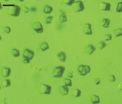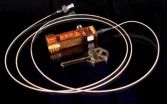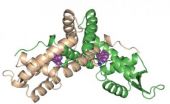(Press-News.org) CORVALLIS, Ore. – Electrical engineers at Oregon State University have discovered a way to use high- frequency sound waves to enhance the magnetic storage of data, offering a new approach to improve the data storage capabilities of a multitude of electronic devices around the world.
The technology, called acoustic-assisted magnetic recording, has been presented at a professional conference, and a patent application was filed this week.
Magnetic storage of data is one of the most inexpensive and widespread technologies known, found in everything from computer hard drives to the magnetic strip on a credit card. It's permanent, dependable and cheap. However, long-term reliability of stored data becomes an increasing concern as the need grows to pack more and more information in storage devices, experts say.
"We're near the peak of what we can do with the technology we now use for magnetic storage," said Pallavi Dhagat, an associate professor in the OSU School of Electrical Engineering and Computer Science. "There's always a need for approaches that could store even more information in a smaller space, cost less and use less power."
That can be possible, scientists say, if the magnetic materials are temporarily heated, even for an instant, so they can become momentarily less stiff and more data can be stored at a particular spot. This has proven difficult to do, because the heating tends to spread beyond where it is wanted and the technology involves complex integration of optics, electronics and magnetics.
With the new approach, ultrasound is directed at a highly specific location while data is being stored, creating elasticity that literally allows a tiny portion of the material to bend or stretch. It immediately resumes its shape when the ultrasound waves stop. The data can be stored reliably without the concerns around heating.
It should also be possible to create a solid state memory device with no moving parts to implement this technology, researchers said. Unlike conventional hard-disk drive storage, solid state memory would offer durability.
These advances were recently reported at the 12th Joint MMM/Intermag Conference in Chicago.
"This technology should allow us to marry the benefits of solid state electronics with magnetic recording, and create non-volatile memory systems that store more data in less space, using less power," said Albrecht Jander, also an associate professor of electrical engineering and collaborator on the research.
This approach might work with materials already being used in magnetic recordings, or variations on them, the investigators said. Continued research will explore performance, materials and cost issues.
Advances in data storage are part of what has enabled the enormous advance in high technology systems in recent decades.
A disk drive at the dawn of this era in the 1950s had five megabyte capacity, cost today's equivalent of $160,000, weighed about a ton, had to be moved with a forklift and was so big it had to be shipped on a large cargo aircraft. Experts at the time said they could have built something with more storage capacity, but they could not envision why anyone would want it, or buy it.
A system today that stores 500 gigabytes, or 100,000 times as much information, is found routinely in laptop computers that cost a few hundred dollars.
###
Editor's Note: A graphic image of this technology is available online: http://bit.ly/11v7PkT
Researchers invent 'acoustic-assisted' magnetic information storage
2013-02-15
ELSE PRESS RELEASES FROM THIS DATE:
Leading RSV researcher publishes work at Le Bonheur Children's
2013-02-15
Memphis, Tenn. – Studies at Le Bonheur Children's Hospital in Memphis, Tenn., are advancing our understanding of how viruses, including RSV, replicate in humans, mutate to avoid the immune response and can be effectively treated.
John DeVincenzo, MD, medical director of Molecular Diagnostics and Virology Laboratories at Le Bonheur, and professor of Pediatrics and Microbiology, Immunology, and Molecular Biology at The University of Tennessee Health Science Center, has recently published three papers on this topic. DeVincenzo's lab is one of only two of its kind in the ...
Revealing the secrets of motility in archaea
2013-02-15
The protein structure of the motor that propels archaea has been characterized for the first time by a team of scientists from the U.S. Department of Energy's Lawrence Berkeley National Laboratory (Berkeley Lab) and Germany's Max Planck Institute (MPI) for Terrestrial Microbiology.
The motility structure of this third domain of life has long been called a flagellum, a whip-like filament that, like the well-studied bacterial flagellum, rotates like a propeller. But although the archaeal structure has a similar function, it is so profoundly different in structure, genetics, ...
APS applauds President Obama's support of R&D in SOTU
2013-02-15
WASHINGTON, D.C. – The American Physical Society (APS), the nation's largest organization of physicists, commends President Obama's exhortation in his State of the Union Speech that, "Now is the time to reach a level of research and development not seen since the height of the Space Race."
During the Space Race, the nation made huge investments in scientific research, which led to new discoveries, accelerated technological advancements and generated new innovations and businesses.
The President also noted that sequestration -- automatic spending cuts scheduled to occur ...
A dual look at photosystem II using the world's most powerful X-ray laser
2013-02-15
From providing living cells with energy, to nitrogen fixation, to the splitting of water molecules, the catalytic activities of metalloenzymes – proteins that contain a metal ion – are vital to life on Earth. A better understanding of the chemistry behind these catalytic activities could pave the way for exciting new technologies, most prominently artificial photosynthesis systems that would provide clean, green and renewable energy. Now, researchers with the U.S. Department of Energy (DOE)'s Lawrence Berkeley National Laboratory (Berkeley Lab) and the SLAC National Accelerator ...
Noncoding RNAs offer huge therapeutic and diagnostic potential
2013-02-15
New Rochelle, NY, February 14, 2013—As scientists continue to unravel the complexity of the human genome and to uncover vital elements that play a role in both normal physiology and disease, one particular class of elements called noncoding RNAs is gaining a lot of attention. Guest Editor Tom Cech, PhD and Executive Editor Fintan Steele, PhD explore the enormous potential value of this rapidly advancing research area in their Editorial " The (Noncoding) RNA World." The authors introduce a special research section on noncoding RNAs published in the current issue of Nucleic ...
Building healthy bones takes guts
2013-02-15
EAST LANSING, Mich. — In what could be an early step toward new treatments for people with osteoporosis, scientists at Michigan State University report that a natural probiotic supplement can help male mice produce healthier bones.
Interestingly, the same can't be said for female mice, the researchers report in the Journal of Cellular Physiology.
"We know that inflammation in the gut can cause bone loss, though it's unclear exactly why," said lead author Laura McCabe, a professor in MSU's departments of Physiology and Radiology. "The neat thing we found is that a probiotic ...
New methodology to predict pandemics
2013-02-15
NEW YORK – February 13, 2013 – EcoHealth Alliance, the nonprofit organization that focuses on local conservation and global health issues, announced new research focused on the rapid identification of disease outbreaks in the peer reviewed publication, Journal of the Royal Society Interface. The article, authored by leading scientists in the fields of emerging disease ecology, biomathematics, computational biology and bioinformatics, shows how network theory can be used to identify outbreaks of unidentified diseases. The strategy builds on the wealth of online surveillance ...
Quantum cryptography put to work for electric grid security
2013-02-15
LOS ALAMOS, N.M., Feb. 14, 2013—A Los Alamos National Laboratory quantum cryptography (QC) team has successfully completed the first-ever demonstration of securing control data for electric grids using quantum cryptography.
The demonstration was performed in the electric grid test bed that is part of the Trustworthy Cyber Infrastructure for the Power Grid (TCIPG) project at the University of Illinois Urbana-Champaign (UIUC) that was set up under the Department of Energy's Cyber Security for Energy Delivery Systems program in the Office of Electricity Delivery and Energy ...
A microbial biorefinery provides new insight into how bacteria regulate genes
2013-02-15
PROVIDENCE, R.I. [Brown University] — Microorganisms that can break down plant biomass into the precursors of biodiesel or other commodity chemicals might one day be used to produce alternatives to petroleum. But the potential of this "biorefinery" technology is limited by the fact that most microorganisms cannot break down lignin, a highly stable polymer that makes up as much as a third of plant biomass.
Streptomyces bacteria are among few microorganisms known to degrade and consume lignin. Now a group of researchers at Brown University has unlocked the genetic and molecular ...
NASA's Fermi proves supernova remnants produce cosmic rays
2013-02-15
A new study using observations from NASA's Fermi Gamma-ray Space Telescope reveals the first clear-cut evidence the expanding debris of exploded stars produces some of the fastest-moving matter in the universe. This discovery is a major step toward understanding the origin of cosmic rays, one of Fermi's primary mission goals.
"Scientists have been trying to find the sources of high-energy cosmic rays since their discovery a century ago," said Elizabeth Hays, a member of the research team and Fermi deputy project scientist at NASA's Goddard Space Flight Center in Greenbelt, ...





